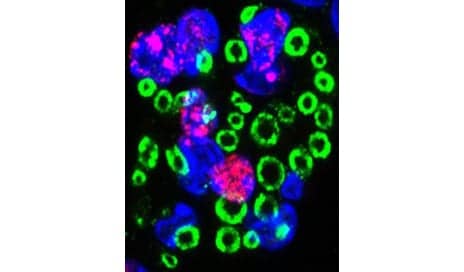
Pictured here is a confocal micrograph taken from the lesion core after a spinal cord injury. Nuclear EdU (red) shows the presence of newly differentiated cells, which produce Schwann cell myelin (P0, green). These peripheral-like Schwann cells remyelinate central axons in the injured spinal cord and are important for spontaneous repair and functional recovery after spinal cord injury. (Photo courtesy of King’s College London)
Researchers at King’s College London and the University of Oxford suggest that a molecular signal known as neuregulin-1 acts to help repair the spinal cord after injury.
Neuregulin-1 signals from the surface of damaged nerve fibers during a process called “spontaneous remyelination,” which takes place following a spinal cord injury. The process takes place as a result of damage to spinal nerve fibers that have lost their “myelin sheath,” which is crucial for effective communication between the brain and the body, explains a media release from King’s College London.
In their study, published recently in Brain, the research team notes that in mice that lacked the neuregulin-1 gene, spontaneous myelin repair was prevented and spinal nerve fibers were unable to send signals along the spinal cord.
They also observed that mice without neuregulin-1 demonstrated worse outcomes after spinal cord injury—particularly in walking, balance, and coordinated movements—compared to mice that had the neuregulin-1 gene intact.
“By enhancing this spontaneous response, we may be able to significantly improve spinal cord function after injury,” states Elizabeth Bradbury, professor of Regenerative Medicine & Neuroplasticity at the Institute of Psychiatry, Psychology & Neuroscience (IoPPN), King’s College London, and Medical Research Council Senior Fellow, and one of the study’s authors, in the release.
“Our research also has wider implications for other disorders of the central nervous system which share this demyelinating pathology, such as multiple sclerosis,” she adds.
Study author Dr Katalin Bartus, also from the IoPPN, says in the release that, “We hope this work will provide a platform for future research, in which it will be important to test how enhancing levels of neuregulin-1 will improve functional outcome after spinal cord injury.”
[Source(s): King’s College London, Science Daily]




